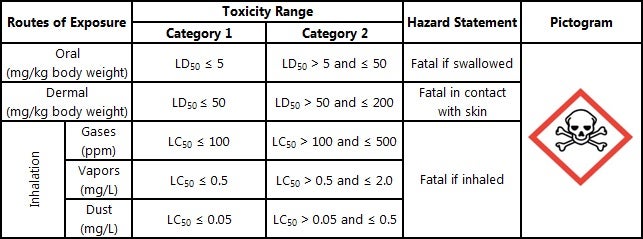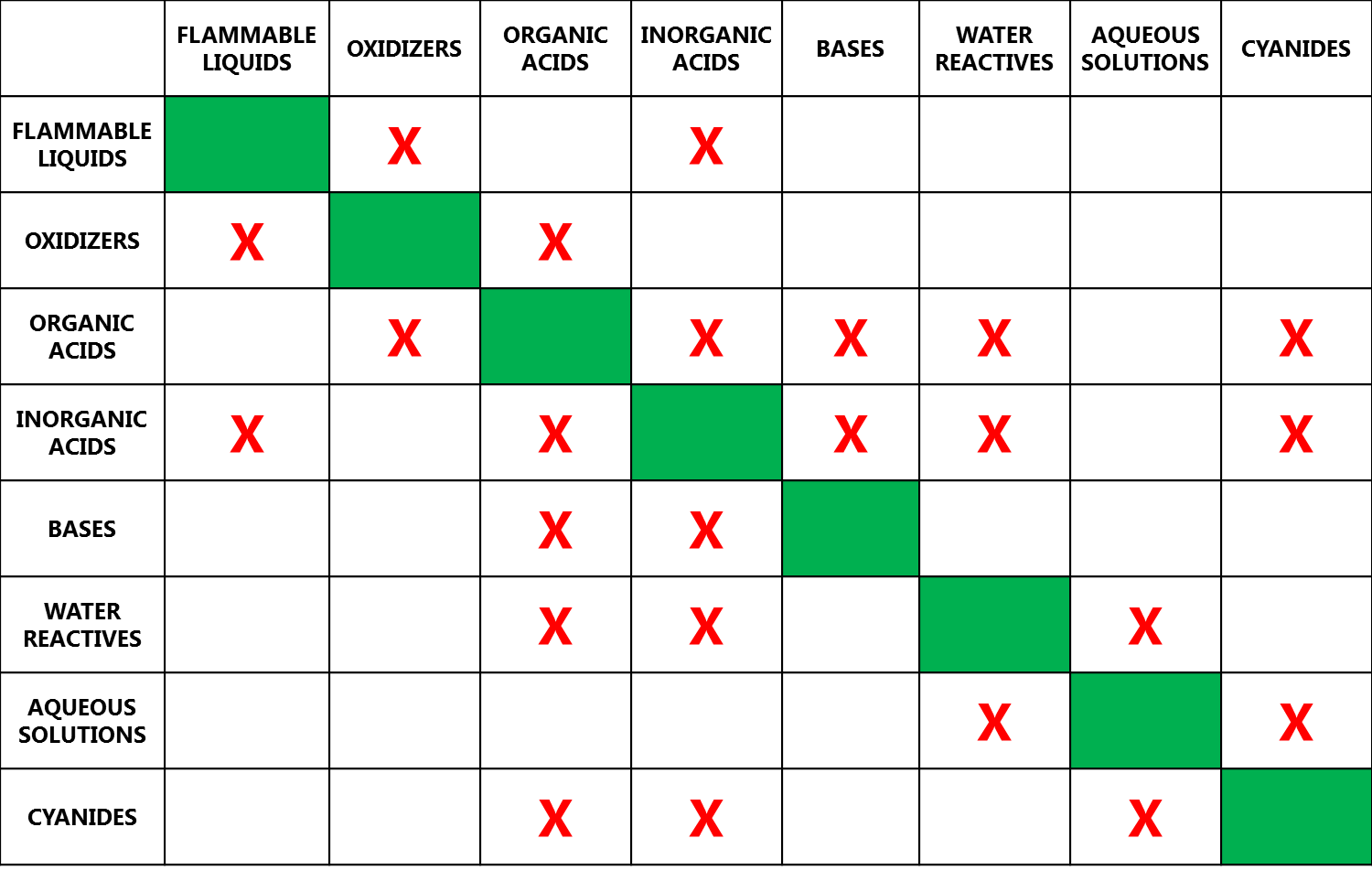Chemical storage and handling information will vary based on the hazards present in the lab.
Particularly Hazardous Substances are classified by Cal/OSHA as substances that pose a significant threat to human health and divided into three primary types: Acute Toxicants, Reproductive Toxicants, and Carcinogens.UCLA Policy 907 provides general guidance on how to work safely with chemicals that have been designated as PHS.
Example of how to comply with UCLA Policy 907
Acute Toxicants are interpreted by OSHA as being substances that “may be fatal or cause damage to target organs as the result of a single exposure or exposures of short duration”
-Acute toxicants are identified by referring to the lethal does (LD50) or lethal concentration (LC50) value located in the Safety Data Sheet
-Refer to Acute Toxicity in Section 11: Toxicological Information of the Safety Data Sheet
Reproductive Toxicants are chemicals that may affect reproductive capabilities, including chromosomal damage (mutations) and effects on fetuses (teratogenesis)
-Reproductive toxicants are identified by the health hazard GHS pictogram on the chemical label
-Refer to Reproductive Toxicity in Section 11: Toxicological Information of the Safety Data Sheet
Carcinogens are chemicals or physical agents that increase the likelihood of getting cancer by exposure to a large concentration over a small period of time or short-term exposures over a long period of time.The biggest concern about carcinogens is that the effects may only become evident after a long latency period.
-Carcinogens are separated into 3 classifications: Select Carcinogens are materials which meet criteria defined by National Toxicology Program (NTP) or the International Agency for Research on Cancer (IARC) regarding the risk of cancer via certain exposure routes, but may also include compounds that have not yet been subjected to testing for carcinogenicity
-Annual Report on Carcinogens published by NTP includes all substances listed as “known to be carcinogens” and “reasonably anticipated to be carcinogens”
-IARC identifies carcinogenicity based on groups
-Group 1 – Carcinogen to Humans
-Group 2A – Probably Carcinogenic to Humans
-Group 2B – Possibly Carcinogenic to Humans
-Regulated Carcinogens fall into a higher hazard class of carcinogens and have extensive additional requirements associated with them
-Permissible Exposure Limits (PEL) are defined as either a 8-hour Time Weighted Average (TWA) or a 15 minute Short Term Exposure Limit (STEL)
-Utilize administrative and engineering controls
-Personal exposure sampling may be required based on the usage
-Listed Carcinogens are the highest class of carcinogens that have further requirements in addition to those of regulated carcinogens
-There are 13 chemicals defined as listed carcinogens
-In addition to the strict regulations of storage/handling, EH&S must be contacted before any work with listed carcinogens
-Carcinogens are identified by the health hazard GHS pictogram on the chemical label
-Refer to Carcinogenicity in Section 11: Toxicological Information of the Safety Data Sheet

Flammable liquids are defined as having a flash point below 100 °F and designated as either Category 1 or 2 in Section 2: Hazards Identification of the Safety Data Sheet (SDS).Be wary that the vapor emitted from the flammable liquid also poses a risk and could be ignited with a simple spark.
-Store flammables in approved flammable cabinets when not in-use
-Keep them stored away from oxidizers and combustible materials utilizing secondary containment or separate storage cabinets to prevent the possibility of fueling a possible fire outbreak
-No more than 10 gallons of flammables may be stored outside of an approved flammable cabinet
-Flammable containers larger than 1 gallon (4L) must be kept inside an approved flammable cabinet
-No storage of flammables in refrigerators or freezers unless it has been approved for storage by the manufacturer
As a health hazard, corrosive substances cause destruction of, or alterations in, living tissue by chemical action at the site of contact.As a physical hazard, corrosive substances may corrode materials they come in contact with and may be high reactive with other substances.
-For corrosives 1M and/or greater, store in a secondary container and below eye-level
-Segregate corrosives with the following logic in-mind:
-Acids away from bases
-Flammable acids (organic) away from oxidizing acids (inorganic)
-Acids away from Cyanide salts
-Spill kit should contain enough neutralizer to neutralize a spill <1 L
-Hydrofluoric Acid (HF) users should refer to the lab’s Standard Operating Procedure
-First-aid kit should contain Calcium Gluconate cream for lab’s with HF
-Concentrated Perchloric Acid (>70%) needs to be handled in a special fume hood with a wash-down system
-Consult with EH&S prior to distilling corrosives in the fume hood
Peroxide formers are chemicals that may form potentially explosive organic peroxides via exposure to oxygen or light and even through distillation of the PFC.There are 4 classes of PFCs, but we are primarily focused on Class 1, 2 and 3 PFCs.
-Label the bottle with the date when received and date opened
-Use or dispose of the chemical within 12 months of opening or by the expiration date, whichever date is earliest
-Labs may test the chemical for peroxide formation to keep the chemical beyond 1 year of the opening date
-If the ppm level for peroxides is below the limit, the lab may keep the PFC as long as it is continues to be tested for peroxides
-If the ppm level for peroxides is too high, a vendor will need to be called in to dispose of it and the cost of the vendor will be billed to the lab/department
-Labs will be charged $100 for each PFC going beyond 1 year of the opening date
Pyrophoric chemicals are a special classification of reactive materials that spontaneously combust when in contact with air and require laboratory specific training.Due to the hazardous nature of the chemical, pyrophorics must be handled under an inert atmosphere or in such a way that rigorously excludes air.
-Flame resistant lab coats must be worn when handling pyrophoric materials
-Pyrophorics may only be stored/handled in buildings equipped with emergency sprinkler systems
-Personnel should be trained and documented prior handling pyrophorics
-Users of pyrophorics outside a glove box need to watch the pyrophoric training video and be fitted with flame resistant glove liners
Water reactive chemicals will react with water to produce a toxic or flammable gas.Depending on the chemical, some water reactives are sensitive enough to react with the moisture in the air.
-Store away from water sources and aqueous solutions
Since many of the hazardous materials can react to form a greater hazard, chemical segregation and storage compatibility is essential to safety inside the lab.Although the use of secondary containers to segregate chemical hazards in the same cabinet is sufficient, ideally it would be best to segregate hazards in different cabinets if storage space is available in the lab.

Labs should be checking the condition of their chemical containers on a routine basis. Over time, chemical containers may deteriorate and become a hazard in the chemical storage areas.
-All containers must be labeled with the constituents
-Labs will be charged $65 for each unknown chemical
-Corroded metal cans should be disposed of from the lab
-If chemically contaminated, dispose of as hazardous waste
-If no chemical contamination, dispose of as non-hazardous waste
-No visible residue or contamination on the outside of the chemical container




